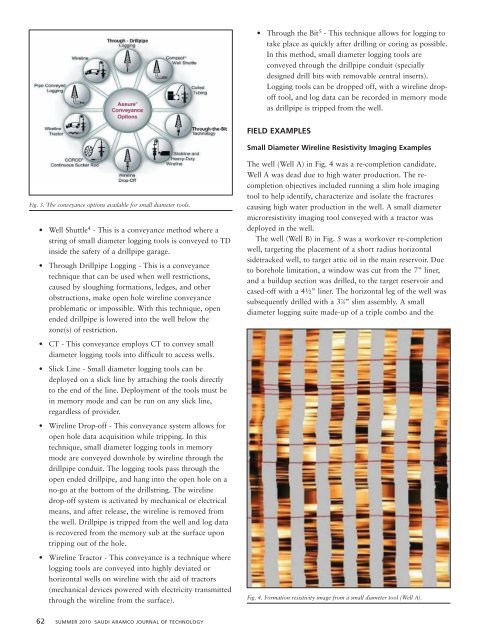English Edition (6 MB pdf) - Saudi Aramco
English Edition (6 MB pdf) - Saudi Aramco
English Edition (6 MB pdf) - Saudi Aramco
You also want an ePaper? Increase the reach of your titles
YUMPU automatically turns print PDFs into web optimized ePapers that Google loves.
• Through the Bit 5 - This technique allows for logging to<br />
take place as quickly after drilling or coring as possible.<br />
In this method, small diameter logging tools are<br />
conveyed through the drillpipe conduit (specially<br />
designed drill bits with removable central inserts).<br />
Logging tools can be dropped off, with a wireline dropoff<br />
tool, and log data can be recorded in memory mode<br />
as drillpipe is tripped from the well.<br />
FIELD EXAMPLES<br />
Small Diameter Wireline Resistivity Imaging Examples<br />
Fig. 3. The conveyance options available for small diameter tools.<br />
• Well Shuttle 4 - This is a conveyance method where a<br />
string of small diameter logging tools is conveyed to TD<br />
inside the safety of a drillpipe garage.<br />
• Through Drillpipe Logging - This is a conveyance<br />
technique that can be used when well restrictions,<br />
caused by sloughing formations, ledges, and other<br />
obstructions, make open hole wireline conveyance<br />
problematic or impossible. With this technique, open<br />
ended drillpipe is lowered into the well below the<br />
zone(s) of restriction.<br />
• CT - This conveyance employs CT to convey small<br />
diameter logging tools into difficult to access wells.<br />
• Slick Line - Small diameter logging tools can be<br />
deployed on a slick line by attaching the tools directly<br />
to the end of the line. Deployment of the tools must be<br />
in memory mode and can be run on any slick line,<br />
regardless of provider.<br />
• Wireline Drop-off - This conveyance system allows for<br />
open hole data acquisition while tripping. In this<br />
technique, small diameter logging tools in memory<br />
mode are conveyed downhole by wireline through the<br />
drillpipe conduit. The logging tools pass through the<br />
open ended drillpipe, and hang into the open hole on a<br />
no-go at the bottom of the drillstring. The wireline<br />
drop-off system is activated by mechanical or electrical<br />
means, and after release, the wireline is removed from<br />
the well. Drillpipe is tripped from the well and log data<br />
is recovered from the memory sub at the surface upon<br />
tripping out of the hole.<br />
• Wireline Tractor - This conveyance is a technique where<br />
logging tools are conveyed into highly deviated or<br />
horizontal wells on wireline with the aid of tractors<br />
(mechanical devices powered with electricity transmitted<br />
through the wireline from the surface).<br />
The well (Well A) in Fig. 4 was a re-completion candidate.<br />
Well A was dead due to high water production. The recompletion<br />
objectives included running a slim hole imaging<br />
tool to help identify, characterize and isolate the fractures<br />
causing high water production in the well. A small diameter<br />
microresistivity imaging tool conveyed with a tractor was<br />
deployed in the well.<br />
The well (Well B) in Fig. 5 was a workover re-completion<br />
well, targeting the placement of a short radius horizontal<br />
sidetracked well, to target attic oil in the main reservoir. Due<br />
to borehole limitation, a window was cut from the 7” liner,<br />
and a buildup section was drilled, to the target reservoir and<br />
cased-off with a 4½” liner. The horizontal leg of the well was<br />
subsequently drilled with a 3 7 ⁄8” slim assembly. A small<br />
diameter logging suite made-up of a triple combo and the<br />
Fig. 4. Formation resistivity image from a small diameter tool (Well A).<br />
62 SUMMER 2010 SAUDI ARAMCO JOURNAL OF TECHNOLOGY

















